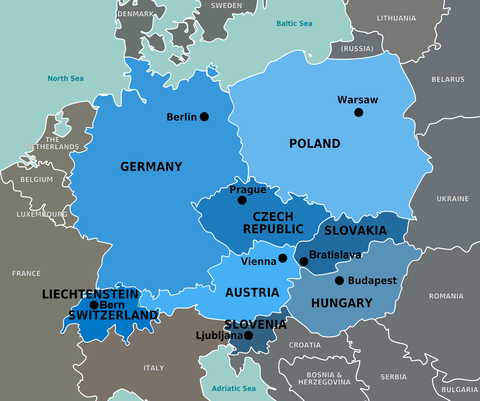Proximity and Efficiency: Central Europe Becomes a Hub for Bike Production
The bicycle and e-bike industry is undergoing a transformative shift in 2025, with Central Europe (C
moreXtreme Fitness Gyms Targets Dominance in Eastern European Fitness Market
Polish fitness franchise Xtreme Fitness Gyms is making waves in the fitness industry, celebrating th
moreAdidas Expands Presence in Switzerland with Zurich Branch
Adidas, the global sporting goods powerhouse, is strengthening its foothold in Central Europe (CE) b
morePolish Brand 4F Becomes Official Technical Supplier for National Volleyball Teams
Polish sportswear brand 4F has announced a landmark partnership, becoming the official technical sup
moreFriction Labs Joins Crag Sport Portfolio: A New Business Partner for Climbers in Central Europe
Krakow-based Crag Sport, a recognized expert in business development in Central Europe (CE), has exp
more
"Business
Partner search for the Sports industry in Central Europe"
Ce Sport for Business partner search for the sports industry in Central Europe
 2014-09-25
source own
2014-09-25
source own
The Central European region is a market which has undergone significant economic and political changes in recent years. The most influential change originated from the collapse of the Soviet Union, along with the subsequent fall of the Berlin Wall in 1989, which triggered the reunification of West and East Germany. Central Europe is recognised as a group of 8 countries which are Austria, Germany, Switzerland, Slovenia, Czech Republic, Hungary, Poland and Slovakia ( see map of central Europe ) which collectively has a combined population of 165 million. In 2004 Slovenia, Czech Republic, Hungary, Poland and Slovakia became members of the European Union. Now 10 years after their accession this is often considered one of the EU’s most astounding success stories. Central European countries have built on their historical legacy of resilience and adaptation to the jarring changes after 1989. Thanks to the continued “catch-up” dynamic, comprising of lower wage costs, a reputable and well trained labour force, healthier banking sector, and significantly less public and private debt, their economies are anticipated to continue growing faster than Western Europe.
Central Europe is now a growth engine for the wider EU economy
Central Europe has never in its history been more free, secure, and prosperous Czechs, Hungarians, Poles, and Slovaks have reaped the benefits greatly from the events and transformation of the past 25 years, as have their direct Central Europe neighbor countries such as Austria and Germany. The enlargement of the European Union in May 2004 continues to be an unquestionable success. Central Eastern European nations have embraced democracy, the rule of law, and market economics. The CE region has thrived thanks to the dramatic increase in trade with, and investment from the rest of Europe .
The Central European countries are now better placed not just to benefit from EU membership, but also to shape Europe’s long term future – thereby making their the whole Central European region stronger within it. Since the mid-1990s, Central and Eastern Europe (CEE) has demonstrated exceptionally economic dynamism with the scale of change in this wider region being unprecedented. As a result, today , GDP per capita in the Czech Republic, Slovakia, and Slovenia stands at 75-80% of the EU average while Croatia, Hungary as well as Poland are at 60% , but greatly improving as there is continued potential for growth. In 2014, as the euro zone and the rest of the EU continues its delicate recovery, forecasts suggest a growth difference of about 1 percent between the CEE and Western Europe, with public debt levels well below the European average.
Central Europe is now a growth engine for the wider EU economy
The region is expected to grow faster than Western Europe over the next five to ten years, thanks to its “catch-up” dynamic . This is the time to capitalize on sports business partner opportunities which the growing CE market offers.
Develop your Sports & Bicycle Industry Distributors across the Central European map
Market snapshot
For the Sports, Fitness, Wellness and Bicycle Industry Central Europe clearly offers excellent growth potential. For example, Germany is Europe’s largest market for the Sports Industry in terms of participants and Poland the 8th. Within Europe, Poland has the 2nd highest average growth rate for GYM/Fitness Centre membership, just behind Turkey the market leader for growth. In terms of Sports participation as a percentage of population within Europe, the Central European countries have a lot of potential for growth. They rank in Europe for highest sports participation as a percentage of population at: Austria 5th, Germany 7th, Czech 10th, Russia 11th, Slovakia 14th, Poland 15th, Croatia 17th, Slovenia 20th, and Hungary 21st . In 2013, Germany was the leading European market for bicycle sales with 396, 600 units sold, and represented 20% of all bikes sold in Europe. Russia was Europe’s 5th largest market with 8% of sales, Poland, 7th with 5%, Austria 10th and Czech 11th with 2% each, while Hungary, Romania, and Bulgaria had a combined market share of 4% of Europe’s total bike sales in 2013, or a total of 700, 000 units sold.
As well as Central Europe, CeSport has a strong presence in developing Eastern European countries such as Russia, Bulgaria, Croatia, Romania, Serbia, Bosnia, Turkey, Belarus, Estonia, Latvia, Lithuania helping companies find sports business partner opportunities across Central and Eastern Europe.
Do you want to improve your market share for your sports business in Central Europe?
We know how to develop your Sporting goods business in Central Europe and therefore where your potential distributors, dealers and retailers are. Do you? contact albert( @ )cesport.eu to learn more.









